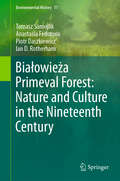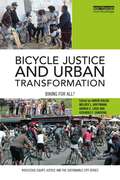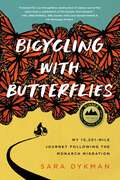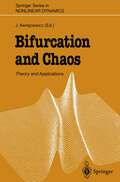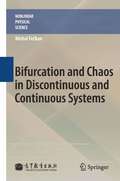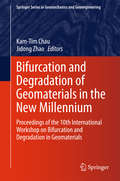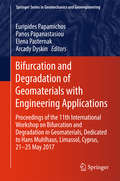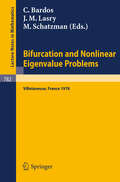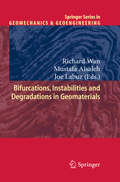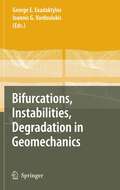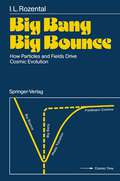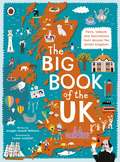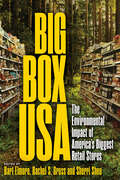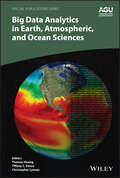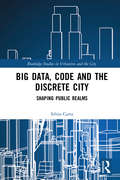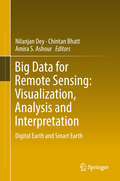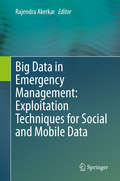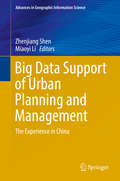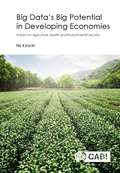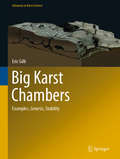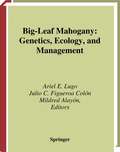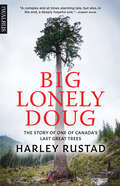- Table View
- List View
Białowieża Primeval Forest: Nature and Culture in the Nineteenth Century (Environmental History #11)
by Tomasz Samojlik Ian D. Rotherham Anastasia Fedotova Piotr DaszkiewiczUnderstanding the current state and dynamics of any forest is extremely difficult - if not impossible - without recognizing its history. Białowieża Primeval Forest (BPF), located on the border between Poland and Belarus, is one of the best preserved European lowland forests and a subject of myriads of works focusing on countless aspects of its biology, ecology, management. BPF was protected for centuries (15th-18th century) as a game reserve of Polish kings and Lithuanian grand dukes. Being, at that time, a part of the Grand Duchy of Lithuania, BPF was subject to long-lasting traditional, multi-functional utilisation characteristic for this part of Europe, including haymaking on forest meadows, traditional bee-keeping and fishing in rivers flowing through forest. This traditional model of management came to an abrupt end due to political change in 1795, when Poland and Grand Duchy of Lithuania ceased to exist in effect of partitioning by neighbouring countries, and the territory of BPF was taken over by the Russian Empire. The new Russian administration, influenced by the German trends in forestry, attempted at introducing the new, science-based forestry model in the BPF throughout the 19th century. The entire 19th century in the history of BPF is a story of struggle between new trends and concepts brought and implemented by new rulers of the land, and the traditional perception of the forest and forest uses, culturally rooted in this area and originating from mediaeval (or older) practices.The book will show the historical background and the outcome of this struggle: the forest’s history in the long 19th century focusing on tracking all cultural imprints, both material (artificial landscapes, introduced alien species, human-induced processes) and immaterial (traditional knowledge of forest and use of forest resources, the political and cultural significance of the forest) that shaped the forest’s current state and picture. Our book will deliver a picture of a crucial moment in forest history, relevant not only to the Central Europe, but to the continent in general. Moment of transition between a royal hunting ground, traditional type of use widespread throughout Europe, to a modern, managed forest. Looking at main obstacles in the management shift, the essential difference in perceptions of the forest and goods it provides in both modes of management, and the implications of the management change for the state of BPF in the long 19th century could help in better understanding the changes that European forests underwent in general.
Bicycle Justice and Urban Transformation: Biking for all? (Routledge Equity, Justice and the Sustainable City series)
by Aaron Golub Melody L. Hoffmann Adonia E. Lugo Gerardo F. SandovalAs bicycle commuting grows in the United States, the profile of the white, middle-class cyclist has emerged. This stereotype evolves just as investments in cycling play an increasingly important role in neighborhood transformations. However, despite stereotypes, the cycling public is actually quite diverse, with the greatest share falling into the lowest income categories. Bicycle Justice and Urban Transformation demonstrates that for those with privilege, bicycling can be liberatory, a lifestyle choice, whereas for those surviving at the margins, cycling is not a choice, but an often oppressive necessity. Ignoring these "invisible" cyclists skews bicycle improvements towards those with choices. This book argues that it is vital to contextualize bicycling within a broader social justice framework if investments are to serve all street users equitably. "Bicycle justice" is an inclusionary social movement based on furthering material equity and the recognition that qualitative differences matter. This book illustrates equitable bicycle advocacy, policy and planning. In synthesizing the projects of critical cultural studies, transportation justice and planning, the book reveals the relevance of social justice to public and community-driven investments in cycling. This book will interest professionals, advocates, academics and students in the fields of transportation planning, urban planning, community development, urban geography, sociology and policy.
Bicycle Justice and Urban Transformation: Biking for all? (Routledge Equity, Justice and the Sustainable City series)
by Aaron Golub Melody L. Hoffmann Adonia E. Lugo Gerardo F. SandovalAs bicycle commuting grows in the United States, the profile of the white, middle-class cyclist has emerged. This stereotype evolves just as investments in cycling play an increasingly important role in neighborhood transformations. However, despite stereotypes, the cycling public is actually quite diverse, with the greatest share falling into the lowest income categories. Bicycle Justice and Urban Transformation demonstrates that for those with privilege, bicycling can be liberatory, a lifestyle choice, whereas for those surviving at the margins, cycling is not a choice, but an often oppressive necessity. Ignoring these "invisible" cyclists skews bicycle improvements towards those with choices. This book argues that it is vital to contextualize bicycling within a broader social justice framework if investments are to serve all street users equitably. "Bicycle justice" is an inclusionary social movement based on furthering material equity and the recognition that qualitative differences matter. This book illustrates equitable bicycle advocacy, policy and planning. In synthesizing the projects of critical cultural studies, transportation justice and planning, the book reveals the relevance of social justice to public and community-driven investments in cycling. This book will interest professionals, advocates, academics and students in the fields of transportation planning, urban planning, community development, urban geography, sociology and policy.
Bicycling with Butterflies: My 10,201-Mile Journey Following the Monarch Migration
by Sara DykmanScience, nature, and adventure come together in Sara Dykman's riveting account of her solo bike trip along the 10,201 mile-long migratory path of the monarch butterfly.
Bifurcation and Chaos: Theory and Applications (Springer Series in Nonlinear Dynamics)
by Jan AwrejcewiczA collection of especially written articles describing the theory and application of nonlinear dynamics to a wide variety of problems encountered in physics and engineering. Each chapter is self-contained and includes an elementary introduction, an exposition of the state of the art, as well as details of recent theoretical, computational and experimental results. Included among the practical systems analysed are: hysteretic circuits, Josephson circuits, magnetic systems, railway dynamics, rotor dynamics and nonlinear dynamics of speech. This book provides important information and ideas for all mathematicians, physicists and engineers whose work in R & D or academia involves the practical consequences of chaotic dynamics.
Bifurcation and Chaos in Discontinuous and Continuous Systems (Nonlinear Physical Science)
by Michal Fečkan"Bifurcation and Chaos in Discontinuous and Continuous Systems" provides rigorous mathematical functional-analytical tools for handling chaotic bifurcations along with precise and complete proofs together with concrete applications presented by many stimulating and illustrating examples. A broad variety of nonlinear problems are studied involving difference equations, ordinary and partial differential equations, differential equations with impulses, piecewise smooth differential equations, differential and difference inclusions, and differential equations on infinite lattices as well.This book is intended for mathematicians, physicists, theoretically inclined engineers and postgraduate students either studying oscillations of nonlinear mechanical systems or investigating vibrations of strings and beams, and electrical circuits by applying the modern theory of bifurcation methods in dynamical systems.Dr. Michal Fečkan is a Professor at the Department of Mathematical Analysis and Numerical Mathematics on the Faculty of Mathematics, Physics and Informatics at the Comenius University in Bratislava, Slovakia. He is working on nonlinear functional analysis, bifurcation theory and dynamical systems with applications to mechanics and vibrations.
Bifurcation and Degradation of Geomaterials in the New Millennium: Proceedings of the 10th International Workshop on Bifurcation and Degradation in Geomaterials (Springer Series in Geomechanics and Geoengineering)
by Kam-Tim Chau Jidong ZhaoThis book contains contributions to the 10th International Workshop on Bifurcation and Degradation in Geomaterials held in Hong Kong, May 28-30, 2014. This event marks the silver Jubilee anniversary of an international conference series dedicated to the research on localization, instability, degradation and failure of geomaterials since 1988 when its first workshop was organized in Germany. This volume of book collects the latest progresses and state-of-the-art research from top researchers around the world, and covers topics including multiscale modeling, experimental characterization and theoretical analysis of various instability and degradation phenomena in geomaterials as well as their relevance to contemporary issues in engineering practice. This book can be used as a useful reference for research students, academics and practicing engineers who are interested in the instability and degradation problems in geomechanics and geotechnical engineering.
Bifurcation and Degradation of Geomaterials with Engineering Applications: Proceedings of the 11th International Workshop on Bifurcation and Degradation in Geomaterials dedicated to Hans Muhlhaus, Limassol, Cyprus, 21-25 May 2017 (Springer Series in Geomechanics and Geoengineering)
by Euripides Papamichos Panos Papanastasiou Elena Pasternak Arcady DyskinThis book contains the scientific contributions to the 11th International Workshop on Bifurcation and Degradation in Geomaterials (IWBDG) held in Limassol-Cyprus, May 21-25, 2017. The IWBDG series have grown in size and scope, since their inception 30 years ago in Germany, covering more and wider areas of geomaterials and geomechanics research including modern trends. The papers cover a wide range of topics including advances in instabilities, localized and diffuse failure, micromechanical, multiscale phenomena, multiphysics modeling and other related topics. This volume gathers a series of manuscript by brilliant international scholars who work on modern recent advances in experimental, theoretical and numerical methods. The theoretical and applied mechanics are linked successfully with engineering applications in traditional and in emerging fields, such as geomechanics for the energy and the environment. The quality of the contributed papers has benefited from the peer review process by expert referees. This book can be used as a useful reference for research students, academics and practicing engineers who are interested in the instability and degradation problems in geomaterials, geomechanics, geotechnical engineering and other related applications.
Bifurcation and Nonlinear Eigenvalue Problems: Proceedings, Universite de Paris XIII, Villetaneuse, France, October 2-4, 1978 (Lecture Notes in Mathematics #782)
by C. Bardos J. M. Lasry M. SchatzmanBifurcations, Instabilities and Degradations in Geomaterials (Springer Series in Geomechanics and Geoengineering)
by Richard Wan Mustafa Alsaleh Joe LabuzGeomaterials exhibit complex but rich mechanical behaviour with a variety of failure modes ranging from diffuse to localized deformation depending on stress, density, microstructure, and loading conditions. These failure modes are a result of an instability of material and/or geometric nature that can be studied within the framework of bifurcation theory. Degradation is another related phenomenon arising from cyclic loading, ageing, weathering, chemical attack, and capillary effects, among others. The methodology of analyzing the various types of instabilities is crucial in the adequate modelling and safe design of numerous problems in geomechanics.The present volume contains a sampling of enlarged versions of papers presented at the International Workshop on Bifurcation and Degradations in Geomaterials (IWBDG 2008) held in Lake Louise, Alberta, Canada, May 28-31, 2008. These papers capture the state-of-the-art in the specialized field of geomechanics and contemporary approaches to solving the central issue of failure. Some engineering applications are presented in the areas of energy resource extraction and soil-machine interaction.
Bifurcations, Instabilities, Degradation in Geomechanics
by George Exadaktylos Ioannis G. VardoulakisThis is an up-to-date review of developments in the field of bifurcations and instabilities in geomechanics from some of the world’s leading experts. Leading international researchers and practitioners of the topics debate the developments and applications which have occurred over the last few decades. Beside fundamental research findings, applications in geotechnical, petroleum, mining, and bulk materials engineering are emphasised.
Big Bang Big Bounce: How Particles and Fields Drive Cosmic Evolution
by Iosif L. RozentalIn a foreword, an author usually elucidates the aim of his book and describes an idealized reader to whom it is addressed. The first task - the formulation of the scope of the book - is the easier one, for the second one involves assessing a reader's personality, and no "specification" should warrant the author's being accused of snobbery, underestimating the reader, or other sins of that kind. It is natural to commence with the first task. The last two decades have been marked by extreme, albeit somewhat unexpected, progress in the unifying approaches to fundamental physical theories. During the same time, a reasonably consistent picture of the early stages in the evolution of the Universe, starting from the time'" 1 s reckoned from the beginning of its inflation, began to take shape. These questions have been separately treated at very different levels; their systematic presentation is the subject of monographs, sometimes very solid ones, containing many formulas not tractable for a layman.
The Big Book of the UK: Facts, folklore and fascinations from around the United Kingdom
by Imogen Russell WilliamsWelcome...Fáilte...Croeso...Fair faa ye...to the United Kingdom!The Big Book of the UK introduces readers to customs and culture of the United Kingdom. Learn about the sport of "dwile flonking" and find out where black diamonds come from. Meet the supernatural animal that haunts the Scottish Highlands and discover the British sweets that helped Hillary and Tenzing scale Everest.Filled with facts about wildlife, food, sports, geography, language and some very silly place names, this book will help you uncover national secrets and unearth local legends from England, Wales, Scotland and Northern Ireland.
Big Box USA: The Environmental Impact of America’s Biggest Retail Stores (Path to Open)
by Bart Elmore Rachel S. Gross Sherri SheuBig Box USA presents a new look at how the big box retail store has dramatically reshaped the US economy and its ecosystems in the last half century. From the rural South to the frigid North, from inside stores to ecologies far beyond, this book examines the relationships that make up one of the most visible features of late twentieth-century and early twenty-first-century American life. The rise of big box retail since the 1960s has transformed environments on both local and global scales. Almost everyone has explored the aisles of big box stores. The allure of “everyday low prices” and brightly colored products of every kind connect shoppers with a global marketplace. Contributors join a growing conversation between business and environmental history, addressing the ways American retail institutions have affected physical and cultural ecologies around the world. Essays on Walmart, Target, Cabela’s, REI, and Bass Pro Shops assess the “bigness” of these superstores from “smokestacks to coat racks” and contend that their ecological impacts are not limited to the footprints of parking lots and manufacturing but also play a didactic role in educating consumers about their relationships with the environment. A model for historians seeking to bring business and environmental histories together in their analyses of merchant capital’s role in the landscapes of everyday life and how it has remade human relationships with nature, Big Box USA is a must-read for students and scholars of the environment, business, sustainability, retail professionals, and a general audience.
Big Data Analytics in Earth, Atmospheric, and Ocean Sciences (Special Publications)
by Thomas Huang Tiffany C. Vance Christopher LynnesBig Data Analytics in Earth, Atmospheric and Ocean Sciences SPECIAL PUBLICATIONS SERIES Big Data Analytics in Earth, Atmospheric, and Ocean Sciences An ever-increasing volume of Earth data is being gathered. These data are “big” not only in size but also in their complexity, different formats, and varied scientific disciplines. As such, big data are disrupting traditional research. New methods and platforms, such as the cloud, are tackling these new challenges. Big Data Analytics in Earth, Atmospheric, and Ocean Sciences explores new tools for the analysis and display of the rapidly increasing volume of data about the Earth. Volume highlights include: An introduction to the breadth of big earth data analytics Architectures developed to support big earth data analytics Different analysis and statistical methods for big earth data Current applications of analytics to Earth science data Challenges to fully implementing big data analytics The American Geophysical Union promotes discovery in Earth and space science for the benefit of humanity. Its publications disseminate scientific knowledge and provide resources for researchers, students, and professionals.
Big Data Analytics in Earth, Atmospheric, and Ocean Sciences (Special Publications)
by Thomas Huang Tiffany C. Vance Christopher LynnesApplying tools for data analysis to the rapidly increasing volume of data about the Earth An ever-increasing volume of Earth data is being gathered. These data are &“big&” not only in size but also in their complexity, different formats, and varied scientific disciplines. As such, big data are disrupting traditional research. New methods and platforms, such as the cloud, are tackling these new challenges. Big Data Analytics in Earth, Atmospheric, and Ocean Sciences explores new tools for the analysis and display of the rapidly increasing volume of data about the Earth. Volume highlights include: An introduction to the breadth of big earth data analytics Architectures developed to support big earth data analytics Different analysis and statistical methods for big earth data Current applications of analytics to Earth science data Challenges to fully implementing big data analytics The American Geophysical Union promotes discovery in Earth and space science for the benefit of humanity. Its publications disseminate scientific knowledge and provide resources for researchers, students, and professionals.
Big Data, Code and the Discrete City: Shaping Public Realms (Routledge Studies in Urbanism and the City)
by Silvio CartaBig Data, Code and the Discrete City explores how digital technologies are gradually changing the way in which the public space is designed by architects, managed by policymakers and experienced by individuals. Smart city technologies are superseding the traditional human experience that has characterised the making of the public space until today. This book examines how computers see the public space and the effect of algorithms, artificial intelligences and automated processes on the human experience in public spaces. Divided into three parts, the first part of this book examines the notion of discreteness in its origins and applications to computer sciences. The second section presents a dual perspective: it explores the ways in which public spaces are constructed by the computer-driven logic and then translated into control mechanisms, design strategies and software-aided design. This perspective also describes the way in which individuals perceive this new public space, through its digital logic, and discrete mechanisms (from Wi-Fi coverage to self-tracking). Finally, in the third part, this book scrutinises the discrete logic with which computers operate, and how this is permeating into aspects of city life. This book is valuable for anyone interested in urban studies and digital technologies, and more specifically in big data, urban informatics and public space.
Big Data, Code and the Discrete City: Shaping Public Realms (Routledge Studies in Urbanism and the City)
by Silvio CartaBig Data, Code and the Discrete City explores how digital technologies are gradually changing the way in which the public space is designed by architects, managed by policymakers and experienced by individuals. Smart city technologies are superseding the traditional human experience that has characterised the making of the public space until today. This book examines how computers see the public space and the effect of algorithms, artificial intelligences and automated processes on the human experience in public spaces. Divided into three parts, the first part of this book examines the notion of discreteness in its origins and applications to computer sciences. The second section presents a dual perspective: it explores the ways in which public spaces are constructed by the computer-driven logic and then translated into control mechanisms, design strategies and software-aided design. This perspective also describes the way in which individuals perceive this new public space, through its digital logic, and discrete mechanisms (from Wi-Fi coverage to self-tracking). Finally, in the third part, this book scrutinises the discrete logic with which computers operate, and how this is permeating into aspects of city life. This book is valuable for anyone interested in urban studies and digital technologies, and more specifically in big data, urban informatics and public space.
Big Data for Remote Sensing: Digital Earth and Smart Earth
by Nilanjan Dey Chintan Bhatt Amira S. AshourThis book thoroughly covers the remote sensing visualization and analysis techniques based on computational imaging and vision in Earth science. Remote sensing is considered a significant information source for monitoring and mapping natural and man-made land through the development of sensor resolutions that committed different Earth observation platforms. The book includes related topics for the different systems, models, and approaches used in the visualization of remote sensing images. It offers flexible and sophisticated solutions for removing uncertainty from the satellite data. It introduces real time big data analytics to derive intelligence systems in enterprise earth science applications. Furthermore, the book integrates statistical concepts with computer-based geographic information systems (GIS). It focuses on image processing techniques for observing data together with uncertainty information raised by spectral, spatial, and positional accuracy of GPS data. The book addresses several advanced improvement models to guide the engineers in developing different remote sensing visualization and analysis schemes. Highlights on the advanced improvement models of the supervised/unsupervised classification algorithms, support vector machines, artificial neural networks, fuzzy logic, decision-making algorithms, and Time Series Model and Forecasting are addressed. This book guides engineers, designers, and researchers to exploit the intrinsic design remote sensing systems. The book gathers remarkable material from an international experts' panel to guide the readers during the development of earth big data analytics and their challenges.
Big Data in Emergency Management: Exploitation Techniques for Social and Mobile Data
by Rajendra AkerkarThis contributed volume discusses essential topics and the fundamentals for Big Data Emergency Management and primarily focusses on the application of Big Data for Emergency Management. It walks the reader through the state of the art, in different facets of the big disaster data field. This includes many elements that are important for these technologies to have real-world impact. This book brings together different computational techniques from: machine learning, communication network analysis, natural language processing, knowledge graphs, data mining, and information visualization, aiming at methods that are typically used for processing big emergency data. This book also provides authoritative insights and highlights valuable lessons by distinguished authors, who are leaders in this field.Emergencies are severe, large-scale, non-routine events that disrupt the normal functioning of a community or a society, causing widespread and overwhelming losses and impacts. Emergency Management is the process of planning and taking actions to minimize the social and physical impact of emergencies and reduces the community’s vulnerability to the consequences of emergencies. Information exchange before, during and after the disaster periods can greatly reduce the losses caused by the emergency. This allows people to make better use of the available resources, such as relief materials and medical supplies. It also provides a channel through which reports on casualties and losses in each affected area, can be delivered expeditiously. Big Data-Driven Emergency Management refers to applying advanced data collection and analysis technologies to achieve more effective and responsive decision-making during emergencies.Researchers, engineers and computer scientists working in Big Data Emergency Management, who need to deal with large and complex sets of data will want to purchase this book. Advanced-level students interested in data-driven emergency/crisis/disaster management will also want to purchase this book as a study guide.
Big Data Support of Urban Planning and Management: The Experience in China (Advances in Geographic Information Science)
by Zhenjiang Shen Miaoyi LiIn the era of big data, this book explores the new challenges of urban-rural planning and management from a practical perspective based on a multidisciplinary project. Researchers as contributors to this book have accomplished their projects by using big data and relevant data mining technologies for investigating the possibilities of big data, such as that obtained through cell phones, social network systems and smart cards instead of conventional survey data for urban planning support. This book showcases active researchers who share their experiences and ideas on human mobility, accessibility and recognition of places, connectivity of transportation and urban structure in order to provide effective analytic and forecasting tools for smart city planning and design solutions in China.
Big Data’s Big Potential in Developing Economies: Impact on Agriculture, Health and Environmental Security
by Nir KshetriBig data involves the use of sophisticated analytics to make decisions based on large-scale data inputs. It is set to transform agriculture, environmental protection and healthcare in developing countries. This book critically evaluates the developing big data industry and market in these countries and gives an overview of the determinants, performance and impacts. It provides a detailed analysis of technology creation, technology infrastructures and human skills required to utilize big data while discussing novel applications and business models that make use of it to overcome healthcare barriers. The book also offers an analysis of big data's potential to improve environmental monitoring and protection where it is likely to have far-reaching and profound impacts on the agricultural sector. A key question addressed is how gains in agricultural productivity associated with big data will benefit smallholder farmers relative to global multinationals in that sector. The book also probes big data's roles in the creation of markets that can improve the welfare of smallholder farmers. Special consideration is given to big data-led transformation of the financial industry and discusses how the transformation can increase small-holder farmers' access to finance by changing the way lenders assess creditworthiness of potential borrowers. It also takes a look at data privacy and security issues facing smallholder farmers and reviews differences in such issues in industrialized and developing countries. The key ideas, concepts and theories presented are explored, illustrated and contrasted through in-depth case studies of developing world-based big data companies, and deployment and utilization of big data in agriculture, environmental protection and healthcare.
Big Karst Chambers: Examples, Genesis, Stability (Advances in Karst Science)
by Eric GilliThis book documents and describes 32 natural caves from France and around the globe that have a width larger than 50 m, including data on the largest underground chamber in the world: Sarawak Chamber. Artificial caves are not able to be constructed at these volumes and most of these naturally forming chambers had never been surveyed before with little geological data available. Methodologies for studying these large volume Karst chambers are described and for each site, a survey, a geomorphological sketch, a description and photographic images are provided. The process of the mechanical transportation by underground running water, of an insoluble but erodible rock located below thick limestone roofs via digging, scouring and racking are explained through these example to clarify the genesis of the largest volumes in the world. The purpose of this study was to estimate whether these natural contexts could be transposed to the digging of artificial caverns to accommodate underground nuclear power plants. Indeed, the comparison of the effects of the Lucens nuclear accident with those of Chernobyl and Fukushima shows the whole interest of an underground solution. These examples of natural chambers indisputably show that this is possible.
Big-Leaf Mahogany: Genetics, Ecology, and Management (Ecological Studies #159)
by Ariel E. Lugo Julio C. Figueroa Ón Mildred AlayónBig-Leaf Mahogany is the most important commercial timber species of the tropics. Current debate concerning whether to protect it as an endangered species has been hampered by the lack of complete, definitive scientific documentation. This book reports on vital research on the ecology of big-leaf mahogany, including genetic variations, regeneration, natural distribution patterns and the silvicutural and trade implications for the tree.
Big Lonely Doug: The Story of One of Canada’s Last Great Trees
by Harley RustadIn the tradition of John Vaillant’s modern classic The Golden Spruce comes a story of the unlikely survival of one of the largest and oldest trees in Canada.On a cool morning in the winter of 2011, a logger named Dennis Cronin was walking through a stand of old-growth forest near Port Renfrew on Vancouver Island. He came across a massive Douglas fir the height of a twenty-storey building. Instead of allowing the tree to be felled, he tied a ribbon around the trunk, bearing the words “Leave Tree.” The forest was cut but the tree was saved. The solitary Douglas fir, soon known as Big Lonely Doug, controversially became the symbol of environmental activists and their fight to protect the region’s dwindling old-growth forests.Originally featured as a long-form article in The Walrus that garnered a National Magazine Award (Silver), Big Lonely Doug weaves the ecology of old-growth forests, the legend of the West Coast’s big trees, the turbulence of the logging industry, the fight for preservation, the contention surrounding ecotourism, First Nations land and resource rights, and the fraught future of these ancient forests around the story of a logger who saved one of Canada's last great trees.
